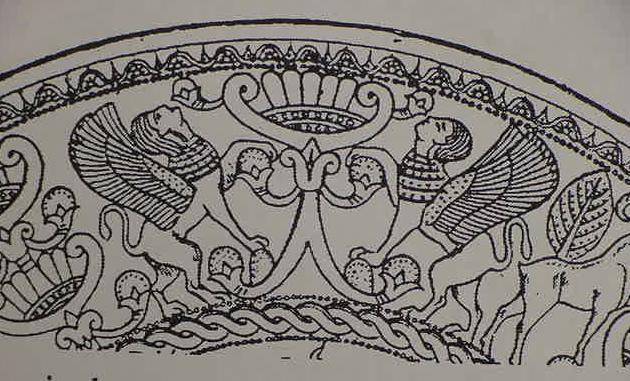Pharaoh Thuthmose IV ca. 1419-1386 BCE, honoring the Giza Sphinx, whom he calls Hor-em-akhet, "Horus of the Horizon," which guarded the Great Pyramids. This scene is from a stela erected at the base of the great Giza Sphinx, between its fore-legs or paws. The two sphinxes symbolize that they are guardians of the Sun which rises and sets from the horizon. Sometimes they are understood as being the mountains of the horizon from which the sun rises and sets, hence the reason they are shown, back-to-back, as in this scene. Note the rising sun with hawk's wings called "Horus of Bedhety," that is Horus has assumed the form of the Sun in order to see all his earthly enemies from up high and destroy them. Horus is, confusingly, not only "the son" of the sun-god Ra, but _the sun_ as Horus Behdety ! (cf. figure 3. p. 134. "Horizon." Richard H. Wilkinson.
Reading Egyptian Art, A Hieroglyphic Guide to Ancient Egyptian Painting and Sculpture. London. Thames & Hudson. 1992)
Below, Pharaoh as a winged sphinx, trampling on his enemies. Note the Sun disc above his head. Pharaoh Akhenaten was regarded as the Sun in human form by Tell Amarna times, ca. 1350-1334 BCE. The three "stylized" Lotus blossoms, one near Pharaoh's face, two near the sphinx's tail recall the association of the Sun being born of a giant Blue Lotus each day at day-break or morning for all eternity. The object is a bronze cheek-piece, ca. the late 8th century BCE, from a grave at Salamis, Cyprus. (cf. p. 125. Figures 25 & 26. Vassos Karageorghis. Salamis, Die zyprische Metropole des Altertums. Gustav Lubbe Verlag. 1975. [A German translation of the English edition: Salamis in Antiquity. Series: "New Aspects of Antiquity." Edited by Sir Mortimer Wheeler. London. Thames & Hudson. 1969])
Below, a Syrian cylinder seal of the 15th century BCE, showing the head of Egyptian goddess Hathor. Two winged sphinxes, raise their paws to honor the rising winged Sun (called in Egyptian "Horus of Behdety," a son of Ra the sun-god) above her. The Egyptians alternately saw the Sun being born each day as a Golden Calf (the deceased Pharaoh Pepi of the Old Kingdom in Pyramid Texts being called a Golden Calf that rides Ra's solar bark each day), of Hathor or Nut who were Cow-sky-goddesses. To the degree that Hathor/Nut was the the mother of the Sun in its form as Horus, she would be honored by the Sphinxes which are aspects of the Sun (Pharaoh is Ra, Horus and a Sphinx), and perhaps they are here, the mountains of the horizon, from which the sun rises at daybreak (serving as guardians of the rising sun), being born of Hathor (Hat-hor means House of Horus", that portion of the sky through which the sun passes each day). Hathor could take on the form a lioness as Sakhmet, the "eye of Ra" to decimate a rebellious mankind." In tamer moments she was honored as a spotted solar cat. (For the below photo cf. figure 143. Heinz Demisch. Die Sphinx, Geschichte ihrer Darstellung von den Anfangen bis zur Gegenwart. Stuttgart. Verlag Urachhaus Johannes M. Mayer. 1977. ISBN 3-8738-219-7)
